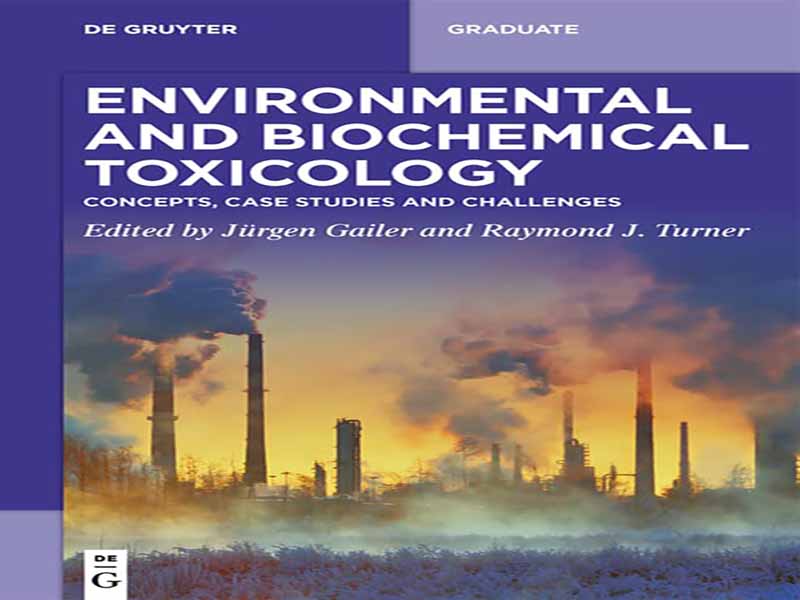- عنوان کتاب: Environmental and Biochemical Toxicology
- نویسنده: Jürgen Gailer, Raymond J. Turner
- حوزه: سم شناسی
- سال انتشار: 2022
- تعداد صفحه: 867
- زبان اصلی: انگلیسی
- نوع فایل: pdf
- حجم فایل: 6.80 مگابایت
ایده تالیف این کتاب ارتباط نزدیکی با دوره جدیدی دارد که برای اولین بار در ترم زمستان 2016 توسط دانشگاه کلگری ارائه شد. این دوره نیز به نوبه خود به دلیل گفتگوهای انتقادی بین JG و RT در مورد روشی که بسیاری از جوامع در سراسر جهان با سمومی که ناخواسته یا عمدا در محیط جهانی منتشر می شوند، برخورد می کنند. برای این منظور، بشر عملاً به یک نیروی بیوژئوشیمیایی جهانی تبدیل شده است (مثلاً بشر قبلاً ترکیب شیمیایی جو زمین را تغییر داده است) که باعث شد یک برنده جایزه نوبل به عصری که ما در حال حاضر در آن زندگی می کنیم به عنوان «انتروپوسین» (انتروپوس) یاد کند. = انسان؛ سن = عصر زمین شناسی). این دیدگاه یا درک این شعار را به چالش میکشد که «راهحل آلودگی رقیقسازی است» و ما را بر آن داشت تا یک دوره جدید بینرشتهای در سطح ارشد ایجاد کنیم که در ابتدا با عنوان «سمشناسی بیوشیمیایی» و در نهایت به «مفاهیم در سمشناسی بیوشیمیایی» تغییر یافت. هدف کلی این دوره تمرکز بر مکانیسمهای بیومولکولی متنوعی بود که توسط آن سموم طبیعی تولید شده توسط ارگانیسمها، و همچنین آلایندههای آلی و معدنی، بر عملکرد سلولی در سطح تک سلولی (میکروها) تأثیر منفی میگذارند. سطح چند سلولی (حیوانات و انسان) و همچنین رابط ارگانیسم-محیط (کل اکوسیستم). با توجه به تخصص مورد نیاز در رابط بین شیمی و زیست شناسی، ارائه این دوره جدید بین رشته ای شامل اعضای هیئت علمی گروه شیمی و علوم زیستی بود. این کتاب از درسهایی استخراج میشود که ما با سازماندهی و ارائه این دوره آموختهایم که شامل تمرکز بر روی رویدادهای شیمیایی است که بلافاصله پس از انتشار سم در محیط رخ میدهد تا توجه دانشآموز را زود به خود جلب کند و زمینههای مهمی را برای موضوعاتی که پوشش دادیم فراهم کند. بنابراین، این کتاب قرار نیست مقدمه ای کامل برای سم شناسی بیوشیمیایی باشد، زیرا چند کتاب درسی اخیر وجود دارد که این طعم را دارند. در عوض، این کتاب باید برای دانشآموزانی که کنجکاو هستند تا مبانی و مکانیسمهای شیمیایی (بیولوژیکی) را که در قلب مشکلات اجتماعی است که به طور پیچیده با اقتصاد و مدیریت نادرست و دفع مواد آلی و معدنی مرتبط است، مورد توجه قرار گیرد. سموم از آنجایی که اولین هدف انتشار هر سمی، منطقه ای است که ما در آن زندگی می کنیم، هر گونه ترشح سمی این پتانسیل را دارد که به اکوسیستمی که از ما حمایت می کند آسیب برساند، که سپس زنجیره غذایی را منتشر می کند. بنابراین نباید تعجب کنیم که بفهمیم آلودگی بزرگترین عامل محیطی بیماری و مرگ زودرس در جهان امروز است. اگرچه تخمین زده می شود که 9 میلیون مرگ زودرس به بیماری های مرتبط با آلودگی در سال 2015 نسبت داده می شود، اما این چیزی است که ما نمی دانیم از نظر تأثیر منفی آلودگی شیمیایی بر سلامت انسان (Landrigan, Fuller et al. 2017) به شکل “تیک زدن بمب های ساعتی” که به ویژه نگران کننده است. ما باید بدانیم که اکنون در حال آغاز سفری هستیم تا مکانیسم های پیچیده ای را کشف کنیم که توسط آن آلاینده ها ابتدا منجر به تغییرات ظریف در زیستگاه بوم شناختی محلی ما می شوند که در نهایت ممکن است منجر به اثرات نامطلوب بر سلامت انسان شود. با توجه به نیاز به یافتن راههای جدید برای رسیدگی تجربی به این مشکل، این کتاب درسی به عنوان نقطه شروعی برای دانشآموزان ارشد برای کشف بیشتر این مرز چالشبرانگیز است.
The idea to compile this book is closely linked to a new course that was offered by the University of Calgary for the first time in the winter term of 2016. This course, in turn, came into existence because of critical conversations between JG and RT about the way that many societies around the world deal with toxins that are inadvertently or deliberately released into the global environment. To this end, mankind has effectively become a global biogeochemical force (e.g. mankind has already been changing the chemical composition of the earth’s atmosphere), which prompted a Nobel laureate to refer to the age that we currently live in as the ‘anthropocene’ (anthropos = human; cene = geological epoch). This perspective or realization challenges the mantra that “the solution to pollution is dilution” and prompted us to develop a new interdisciplinary senior-level course which was initially entitled ‘Biochemical Toxicology’ and eventually changed to ‘Concepts in Biochemical Toxicology’. The overall goal of this course was and is to focus on the diverse biomolecular mechanisms by which natural toxins that are produced by organisms, as well as organic and inorganic pollutants, adversely affect cell function at the single-cell level (microbes), at the multicellular level (animals and humans) as well as the organism–environment interface (entire ecosystems). Owing to the required expertise at the interface between chemistry and biology, the delivery of this interdisciplinary new course involved faculty from the Department of Chemistry and from Biological Sciences. The book draws from the lessons that we have learned by organizing and delivering this course which involved focusing on chemical events that unfold immediately after a toxin is released into the environment to capture the student’s attention early and to provide important context to topics that we covered. Thus, this book is not intended to be a thorough introduction to biochemical toxicology since there are a few recent textbooks that have this flavour. Rather, this book should be of interest for students who are curious to uncover the (bio)chemical basis and mechanisms that are at the heart of the societal problems that are intricately linked to the economy and the associated improper management and disposition of organic and inorganic toxins. Since the first target of any toxin release is the immediate area that we live in, any toxin release has the potential to damage the very ecosystem that supports us, which will then propagate up the food chain. We should therefore not be surprised to learn that pollution is the largest environmental cause of disease and premature death in the world today. Although it is estimated that 9 million premature deaths are attributed to pollution-related diseases in 2015, it is what we don’t know in terms of how chemical pollution adversely affects human health (Landrigan, Fuller et al. 2017) in the form of ‘ticking time-bombs’ that is particularly worrisome. We have to recognize that we are just now embarking on the journey to unravel the complex mechanisms by which pollutants first result in subtle changes to our local ecological habitat, which may eventually result in adverse human health effects. Given the need to find new ways to experimentally address this problem, this textbook serves as a starting point for senior students to further explore this challenging frontier.
این کتاب را میتوانید بصورت رایگان از لینک زیر دانلود نمایید.
Download: Environmental and Biochemical Toxicology




































نظرات کاربران